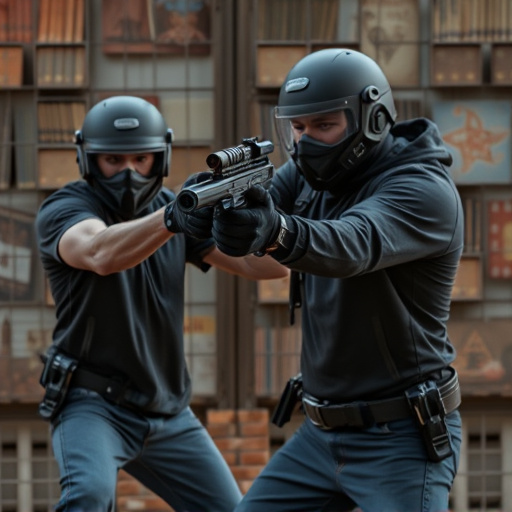Pepper spray's effectiveness in rainy conditions is challenged by water dilution, but capsaicin remains potent. Key factors like concentration, wind, and proximity determine its impact. Heavy rain quickly washes away irritants, rendering it less effective. Water-resistant formulations and enhanced delivery systems are crucial for protection. Proper application techniques and user training ensure reliability despite environmental challenges. Eye protection, aiming for upper body targets, and device maintenance maximize coverage while minimizing dilution.
“Uncover the power of civilian-grade pepper defense spray, a non-lethal self-defense tool gaining popularity. In this comprehensive guide, we explore its effectiveness, especially under wet conditions. From understanding the active ingredients and their mechanism of action to navigating the impact of rain, this article provides insights into optimal performance. Learn how these sprays hold up in various weather, ensuring safety and deterrence. Discover best practices for responsible use, especially when the elements—like rain—come into play.”
- Understanding Pepper Spray: Active Ingredients and Mechanism of Action
- The Impact of Rain on Pepper Spray Performance
- Civilian Grade Pepper Spray: Effectiveness in Different Weather Conditions
- Safety Considerations and Best Practices for Using Pepper Spray in the Rain
Understanding Pepper Spray: Active Ingredients and Mechanism of Action
Pepper spray, a popular self-defense tool, contains capsaicin, the active ingredient derived from chili peppers. This compound irritates the eyes, nose, and respiratory system, causing temporary disorientation and immobilization in the target. When deployed, pepper spray creates a cloud of fine droplets that can be effective up to 20 feet away, ensuring users can maintain a safe distance from potential threats.
One common concern with pepper spray’s effectiveness is its performance in wet conditions, particularly when considering the Pepper Spray Effectiveness in Rain. While water can temporarily dilute the concentration, capsaicin remains active and can still cause significant discomfort and disability. The key factors are the concentration of capsaicin, wind direction and speed, and the proximity of the target to the spray cloud—all of which determine how quickly and effectively the pepper spray will work in any given environment, including rainy conditions.
The Impact of Rain on Pepper Spray Performance
The effectiveness of pepper spray can be significantly impacted by rainfall, as water can dilute and disperse the active ingredients. When used outdoors, pepper spray is designed to create a concentrated cloud of irritants that disrupt an attacker’s vision and breathing. However, rain can quickly wash away this protective barrier, reducing its impact. In particular, heavy rain can rapidly dissipate the spray’s effects, leaving users vulnerable during encounters in wet conditions.
Understanding how rain affects pepper spray performance is crucial for individuals considering self-defense options. It highlights the importance of choosing products specifically designed for maximum effectiveness in adverse weather. Some manufacturers develop civilian-grade pepper sprays that incorporate water-resistant formulations and enhanced delivery systems to counteract these challenges, ensuring users can maintain a level of protection even when caught in the rain.
Civilian Grade Pepper Spray: Effectiveness in Different Weather Conditions
Civilian-grade pepper spray is designed to be a versatile self-defense tool, but its effectiveness can vary based on environmental conditions, particularly weather. One common concern among users is how well it performs in rainy or humid climates. In terms of Pepper Spray Effectiveness in Rain, several factors come into play.
First, water can dilute the concentration of capsaicin, the active ingredient in pepper spray, reducing its impact. However, high humidity can also make it easier for the spray to remain airborne, increasing the likelihood of direct eye and respiratory irritation. Conversely, heavy rain could cause the spray to settle faster, potentially limiting its reach and impact. Ultimately, proper application techniques and training are crucial to ensure its effectiveness regardless of weather conditions.
Safety Considerations and Best Practices for Using Pepper Spray in the Rain
Using civilian-grade pepper spray in rainy conditions can present unique challenges, but with the right safety considerations and best practices, it remains an effective self-defense tool. It’s crucial to understand that pepper spray’s effectiveness in the rain isn’t significantly diminished; however, factors like reduced visibility and water dispersion can impact its range and intensity. To mitigate these issues, users should prioritize eye protection, ensuring their goggles or shield is securely in place before deployment.
When spraying in wet conditions, aim for upper body targets to maximize coverage while minimizing wind and rain’s dilution effect on the spray. Keep a safe distance from your target, allowing the pepper spray to settle and take effect before advancing. Regularly maintain and inspect your pepper spray device, ensuring it’s dry and functional after each use, especially in wet environments. These precautions ensure that civilian-grade pepper spray remains a reliable option for personal safety, even during inclement weather.
While pepper spray’s effectiveness in dry conditions is well-documented, its performance in rainy weather poses unique challenges. The presence of water can reduce the concentration of active ingredients and impact spraying distance. However, proper civilian-grade pepper sprays are designed to maintain potency even in damp environments. By understanding how rain affects spray distribution and adopting safe usage practices, individuals can rely on their pepper spray as a reliable personal defense tool, ensuring its effectiveness in various weather conditions, including rainy ones.
